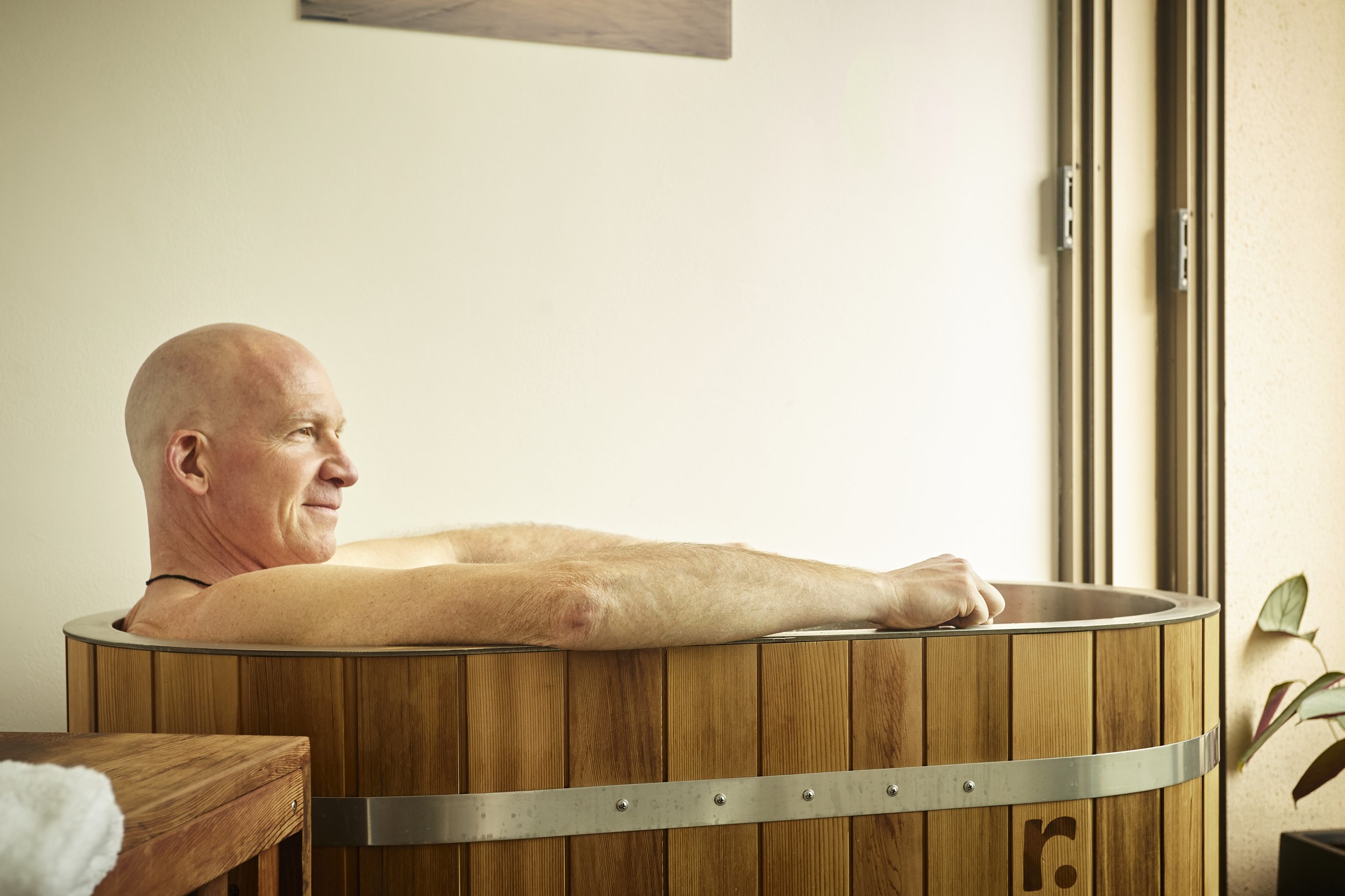
Cold Thermogenesis
Cold Thermogenesis, also known as cold exposure, involves exposing your body to a cold stimulus to elicit physiological responses that increase metabolism. When our bodies are exposed to colder environments, they work harder to maintain internal temperature, which stimulates metabolic processes, increases energy expenditure, and promotes overall well-being.
During cold exposure, the mitochondria in cells burn fuel as infrared light in order to heat the body up to maintain a consistent core body temperature. CT works optimally for humans with maternal ancestors who have faced cold climates in the past and made genetic adaptations to these conditions. In other words, humans who are able to uncouple their mitochondrial metabolism. This means these ancestrally adapted humans’ mitochondria can generate free heat by burning fuel, such as fat, in addition to producing Adenosine Triphosphate (ATP) via the Electron Transport Chain (ETC). Uncoupling is a workout for the mitochondrial matrix—like a gym workout without the inflammatory process.
Cooling of biological surfaces requires an increased demand for energy production by the mitochondria, which boosts metabolism and mitochondrial efficiency.
Hydration is key to warmth after being exposed to cold. This is why before doing any CT, it is advisable to drink 1-2 glasses of cold water.
How Does Cold Thermogenesis Work?
Cold-Induced Thermogenesis (CIT): Cold exposure promotes a process known as cold-induced thermogenesis (CIT), which prompts the body to increase metabolism and heat production.
Activation of brown adipose tissue (BAT): By activating brown adipose tissue (BAT), a type of fat that burns calories to generate heat, cold thermogenesis contributes to increased energy expenditure and changes in glucose metabolism, potentially aiding in weight management.
Activation of cold shock proteins: Activation of cold shock proteins is another significant player in the potential benefits of cold exposure. In response to cold, shock proteins reserved in the liver are dumped into the bloodstream, scouring the body of free radical oxidation, contributing to cellular protection and repair. Cold shock proteins like RBM3 have been directly linked to neurogenesis—the regeneration of neurons and formation of new synaptic connections.
Mitochondrial biogenesis: Cold exposure has been linked to mitochondrial biogenesis, which involves the generation of new mitochondria within cells and therefore increased energy production.
Pain Management and exercise recovery: Cold induces vasoconstriction, limiting blood flow and reducing inflammation in affected areas. It also has a numbing effect, reducing pain signals.
What to Expect:
Session: With minimal clothing, you gradually enter a tub filled with cold water between 5 to 15°C. You’ll start by first immersing your feet and gradually progress to fully submerging your body.
Monitoring: Our trained staff monitor the session to ensure safety and comfort.
Duration: Your cold plunge can last for 1 to 3 minutes to begin with, and in subsequent sessions may be extended to 5 to 10 minutes as tolerated.
Cold Thermogenesis Targets:
Enhanced metabolic rate and calorie burning
Promoting cellular repair and mitochondrial function
Reduced inflammation and swelling
Alleviating pain and discomfort
Improving recovery time after exercise or injury
Boosting mood and mental resilience
For more information:
Brychta RJ, Chen KY. Cold-induced thermogenesis in humans. Eur J Clin Nutr. 2017;71(3):345-352. doi:10.1038/ejcn.2016.223 https://pubmed.ncbi.nlm.nih.gov/27876809/
Langer HT, Cantley LC, Goncalves MD. Live cold to grow old? Thermogenesis to fight cancer. Cell Res. 2022;32(12):1042-1043. doi:10.1038/s41422-022-00723-w https://www.ncbi.nlm.nih.gov/pmc/articles/PMC9715683/
Fan H, Zhang Y, Zhang J, et al. Cold-Inducible Klf9 Regulates Thermogenesis of Brown and Beige Fat. Diabetes. 2020;69(12):2603-2618. doi:10.2337/db19-1153 https://pubmed.ncbi.nlm.nih.gov/32994275/
Yao L, Cui X, Chen Q, et al. Cold-Inducible SIRT6 Regulates Thermogenesis of Brown and Beige Fat. Cell Rep. 2017;20(3):641-654. doi:10.1016/j.celrep.2017.06.069 https://pubmed.ncbi.nlm.nih.gov/28723567/
Wu G, Baumeister R, Heimbucher T. Molecular Mechanisms of Lipid-Based Metabolic Adaptation Strategies in Response to Cold. Cells. 2023;12(10):1353. Published 2023 May 10. doi:10.3390/cells12101353 https://pubmed.ncbi.nlm.nih.gov/37408188/
Cardona A, Pagani L, Antao T, et al. Genome-wide analysis of cold adaptation in indigenous Siberian populations. PLoS One. 2014;9(5):e98076. Published 2014 May 21. doi:10.1371/journal.pone.0098076 https://www.ncbi.nlm.nih.gov/pmc/articles/PMC4029955/
Blondin DP, Daoud A, Taylor T, et al. Four-week cold acclimation in adult humans shifts uncoupling thermogenesis from skeletal muscles to brown adipose tissue. J Physiol. 2017;595(6):2099-2113. doi:10.1113/JP273395 https://www.ncbi.nlm.nih.gov/pmc/articles/PMC5350439/
Gibson OR, Taylor L, Watt PW, Maxwell NS. Cross-Adaptation: Heat and Cold Adaptation to Improve Physiological and Cellular Responses to Hypoxia. Sports Med. 2017;47(9):1751-1768. doi:10.1007/s40279-017-0717-z. https://www.ncbi.nlm.nih.gov/pmc/articles/PMC5554481/

